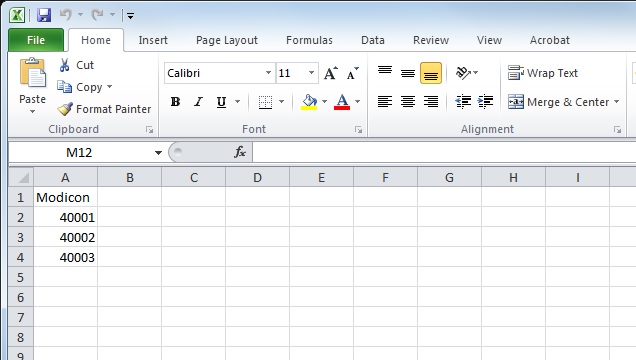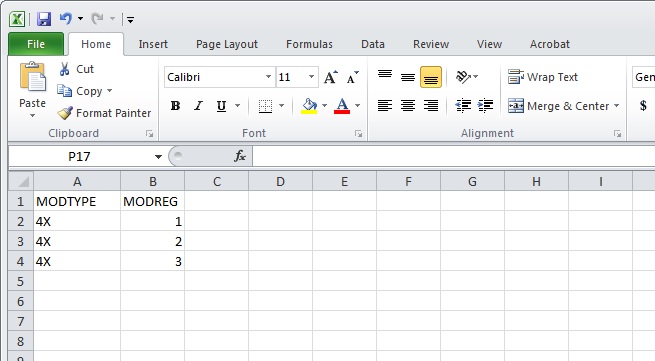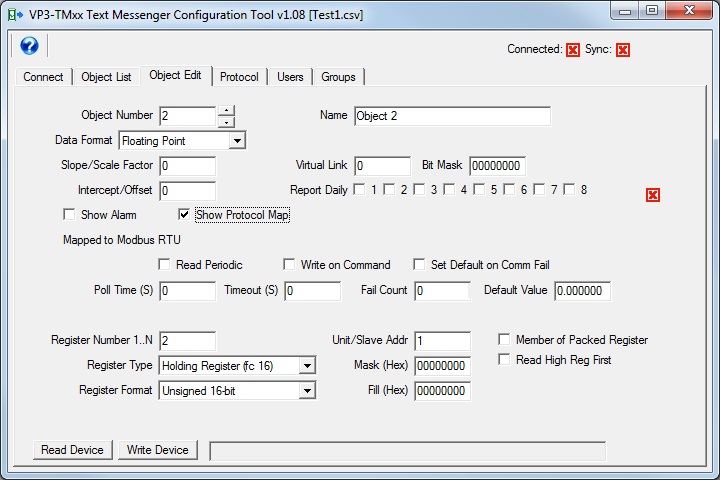

The CSV import capability simplifies the process of creating or changing a large number of entries because you can use any standard spread sheet program to manipulate the content of the CSV file, and then import that into the VP3-TM via the configuration tool. If the VP3-TM will be reading a long list of Modbus registers, for example, you can sometimes just copy a list of registers from another source, paste into a simple text file, and import that into the spread sheet program. Then add a header line to label the content, add a handful of additional columns, and you quickly have most of a complete configuration. Very often, the only thing that changes from one line to the next is the register number. The other entries can be quickly made by entering once and using the spread sheet program's "fill down".

You can quickly create a configuration for a Modbus master that will poll a list of registers by simply providing the list of registers. Everything else will default to the most commonly used parameters. If you are using Modicon notation for the import, the minimum requirement is just a list of registers with a header label MODICON.

The alternative to Modicon notation is just a list of register numbers labeled MODREG that will default to holding registers (4X). You can also add the MODTYPE column to specify register type.

Both of the CSV files illustrated above import to the same configuration illustrated by the Object List above. Picking just one for editing, illustrated below, shows the various default settings that were made.

The minimum requirement for importing a list of Modbus registers is just one of MODREG or MODADDR or MODICON. If MODICON used, then MODTYPE cannot be used because type is implied by the Modicon number. If MODICON is not used, then MODTYPE can be used, but registers will default to holding registers if MODTYPE is not included.
The minimum requirement for importing a list of BACnet objects is BACDEV and BACOBJTYPE and BACOBJINST - all 3 required. Everything else will default.
The NUMBER, NAME, and DATATYPE columns seem like obvious requirements but are actually not included in minimum requirements for an import. Object number will be auto-assigned simply in the order found in the CSV file. Name will default to a generic "Object n" name, and data type will default to floating point.
The following columns are generated by the CSV export of data objects from the Object List page in the VP3-TM configuration tool. This table references the object configuration command that would be used. Refer to the respective commands in Section 7 of this user guide for additional details about certain parameters.
When creating a CSV file for importing, it is not necessary to include all columns, and order is generally not critical. The minimum required columns would be those noted above. In addition, if creating a CSV file for a Modbus model (VP3-TM10, VP3-TM60), do not include columns pertaining to BACnet. Likewise, if creating a CSV file for a BACnet model (VP3-TM30, VP3-TM70), do not include columns pertaining to Modbus.
A simple way of starting a new CSV file is to enter a very minimal 1-object configuration in the configuration tool, and then export a CSV file from the Object List page. The entire header will be created for you. Now simply proceed to fill in additional rows. Feel free to delete unused columns.
| NUMBER | obj 1,xxx Sets object number for the parameters in this line of the CSV file. |
| NAME | obj 1,name=”Engine Temp” Sets object name (ASCII string up to 39 characters). The name must be a quoted string. |
| DATATYPE | obj 1,datatype=FLOAT Sets data type for object’s data. Types are as follows: FLOAT=floating point UINT32=unsigned 32-bit integer INT32=signed 32-bit integer UINT16=unsigned 16-bit integer INT16=signed 16-bit integer BIT=Boolean on/off, 1-bit value |
| LINK | obj 1,link=40 Sets link object (virtual link) for causing the source of data for this object to be some other object, or a virtual object in the system. |
| MASK | obj 1,mask=0080 Sets data mask for use with virtual link. Value is expressed in hexadecimal. Applies to VP3-TM10 and VP3-TM60 only. |
| SCALE | obj 1,scale=1.0000 Sets scale factor, this is multiplied by data value before being stored in object. |
| OFFSET | obj 1,offset=0.0000 Offset added to data value before being stored in object. |
| ALARMTYPE | obj 1,alarm=GT/100.0 Sets alarm type. Alarm type codes are as follows: GT= greater than GE=greater than or equal LT=less than LE=less than or equal *EQ=equal *NE=not equal. DV=deviates from threshold by hysteresis amount CB=changes by NO=none (used in CSV files) |
| ALARMLEVEL | obj 1,alarm=GT/100.0 Sets alarm threshold, second half of alarm command from console. |
| SENDTO | sendto=1+2+4 Indicates one or more notification group numbers 1 through 8 to send the alarm message to. Note that for groups, 1+2 means literally the string "1+2", not 3. Sendto=1+2 will give you groups 1 and 2, while 3 will give you group 3. |
| MINON | obj 1,minon=10 Sets minimum on time for alarm in seconds. |
| MINOFF | obj 1,minoff=0 Sets minimum off time for alarm in seconds. |
| HYST | obj 1,hyst=5.0 Sets hysteresis value applied to alarm thresholds. |
| MESSAGE | obj 1,message=”Send this message when alarm makes transition” Sets the message that will be sent upon alarm transition. |
| ENABLEOBJ | obj 1,enableby=2/30 Selects another object that will enable this alarm. |
| ENABLEDELAY | obj 1,enableby=2/30 The second value is a delay time in seconds. If non-zero, the enable will take effect this amount of time after the given object becomes non-zero. |
| REQUIREACK | obj 1,requireack=yes Selects whether the alarm must be acknowledged by an SMS reply. The yes/no selection is Y or N in the CSV file. |
| ACTIVEONLY | obj 1,activeonly=yes Eliminates the alarm inactive notification when “yes”. The yes/no selection is Y or N in the CSV file. |
| POLL | obj 1,poll=5 Sets poll timer for reading. Setting is in seconds. |
| WRITECOMMAND | obj 1,writecommand=yes Selects whether write on command is enabled for this object. The yes/no selection is Y or N in the CSV file. |
| FAILCOUNT | obj 1,defaultonfail=99.99/3 Tells the communication engine to set the object to a default value upon some number of communication failures. Syntax is defaultonfail=<value>/<count> where <value> is the default value to be set upon <count> failures. In the CSV file, this column is the <count> part. |
| DEFAULTVALUE | obj 1,defaultonfail=99.99/3 Tells the communication engine to set the object to a default value upon some number of communication failures. Syntax is defaultonfail=<value>/<count> where <value> is the default value to be set upon <count> failures. In the CSV file, this column is the <value> part. |
| TIMEOUT | obj 1,timeout=0.5 Sets timeout, in seconds with resolution to tenths. |
| REPORTDAILY | obj 1,reportdaily=1+2+4 Sets the object for daily reporting to the notification groups given. |
| MODREG | obj 1,modreg=201 Sets remote Modbus register number, indexed from 1, not Modicon. |
| MODTYPE | obj 1,modtype=4X Set Modbus register type – determines Modbus function code. Types are: NO=none 0X=coil (read/write) 1X=discrete input (read only) 3X=input register, 16-bit (read only) 4X=holding register, 16-bit (read/write) 0XS=single coil 4XS=single holding register |
| MODDATA | obj 1,moddata=UINT16 Sets Modbus remote register data format. NONE=undefined INT16=signed integer, 16-bit UINT16=unsigned integer, 16-bit INT32=signed integer, 32-bit UINT32=unsigned integer, 32-bit INT64=signed integer, 64-bit FLOAT=floating point, IEEE 754, 32-bit BIT=Boolean, single bit, applies to coil or discrete input ONLY MOD10-2=Schneider Electric Mod10 format, 2-register MOD10-3=Schneider Electric Mod10 format, 3-register MOD10-4=Schneider Electric Mod10 format, 4-register |
| MODMASK | obj 1,modmask=0080 Sets data mask in Modbus map for Modbus bit masking. |
| MODFILL | obj 1,modfill=0080 Sets data fill for use in writing packed registers, has no effect on reading. |
| MODSLAVE | obj 1,modslave=5 Sets Modbus RTU slave address to be read/written for this map. |
| MODTCPDEV | obj 1,modtcp=1/5 Selects the TCP device from device table, and provides TCP unit number instead of RTU slave. Syntax is tcp=<device>/<unit>. Used only in TCP version of device. Both RTU and TCP are simultaneously active in the TCP device. |
| MODTCPUNIT | obj 1,modtcp=1/5 Selects the TCP device from device table, and provides TCP unit number instead of RTU slave. Syntax is tcp=<device>/<unit>. Used only in TCP version of device. Both RTU and TCP are simultaneously active in the TCP device. |
| MODBIGEND | obj 1,modbigend=yes (or no, default=no) Sets Modbus register swap flag for this object map. The yes/no selection is Y or N in the CSV file. |
| MODPACK | obj 1,modpack=yes (or no, default=no) Set this option flag if the same register will be shared among multiple objects using bit masking. Even if a single register is to use a bit mask, this flag must still be set to cause the mask to be recognized. The yes/no selection is Y or N in the CSV file. |
| BACUNITS | obj 1,bacunits=95 Specifies BACnet Units property for this object. |
| BACDEV | obj 1,bacdev=10 Sets remote device instance for BACnet client mapping. |
| BACOBJTYPE | obj 1,bacobj=AI/1 Selects object type which the BACnet client is to read/write at remote device instance. The following object types are supported by the client: AI=Analog Input AO=Analog Output AV=Analog Value BI=Binary Input BO=Binary Output BV=Binary Value MI=Multi-state Input MO=Multi-state Output MV=Multi-state Value DEV=Device |
| BACOBJINST | obj 1,bacobj=AI/1 Selects object instance which the BACnet client is to read/write at remote device instance. |
| BACMAC | obj 1,bacmac=3 (hexadecimal) obj 1,bacmac=c0:a8:0:2:0b:ac (indicates IP address 192.168.0.2 port 47808) If specified, this MAC address will be used by the BACnet client to attempt to reach the remote BACnet device when Who-Is fails. |
| BACPROP | obj 1,bacprop=85 Selects object property to be read/written at remote device. |
| BACDATA | obj 1,bacdata=BIT Specifies data encoding to be used when writing remote device. Supported data encoding types are: NULL=BACnet Application Tag Null (0) BOOL=BACnet Application Tag Boolean (1) UINT=BACnet Application Tag Unsigned Int (2) SINT=BACnet Application Tag Signed Int (3) REAL=BACnet Application Tag Real (4) BIT=BACnet Application Tag BitString (8) ENUM=BACnet Application Tag Enumerated (9) |
| BACPRIORITY | obj 1,bacpriority=10 Specifies the command priority that should be used when writing a commandable object in the remote device.Commandable objects are any Output object. Commandable Value objects are not supported. |
| BACINDEX | obj 1,bacindex=2 Specifies an index value if reading/writing an array, or “no index” if -1. Defaults to “no index”. |
| BACBITNUM | obj 1,bacbitnum=1 Specifies a bit number to read a single bit from a bit string. |
The columns in the User CSV file are as noted in the following table. Import and export of User CSV files is done from the Users page in the configuration tool.
The minimum required columns for a User CSV import are USERSMS and GROUPS. Number will be automatically assigned in the order users are found in the CSV file. Name is not used for sending messages, and therefore is not needed for anything other than reference on the screen of the configuration tool - or in other words, just not really needed.
| NUMBER | user 1,xxx Sets user number for the parameters in this line of the CSV file. |
| USERSMS | user 1,sms=17634155950 Sets phone book entry 1 to the given SMS/phone number. IMPORTANT: The country code, e.g. 1, must be included in the phone number. |
| USERNAME | user 1,name=”John Smith” The name is for reference only (30 char max), displayed for reference on the console. |
| GROUPS | user 1,groups=1+2+7 Selects which groups (1..8) which this user is a member of. A user may be a member of 1 to 8 groups. |
| COMMAND | user 1,command=yes If this user is authorized to send commands via SMS, indicate “yes”, defaults to “no” if omitted. The yes/no selection is Y or N in the CSV file. |
Copyright © 2019 Control Solutions Minnesota, Inc.